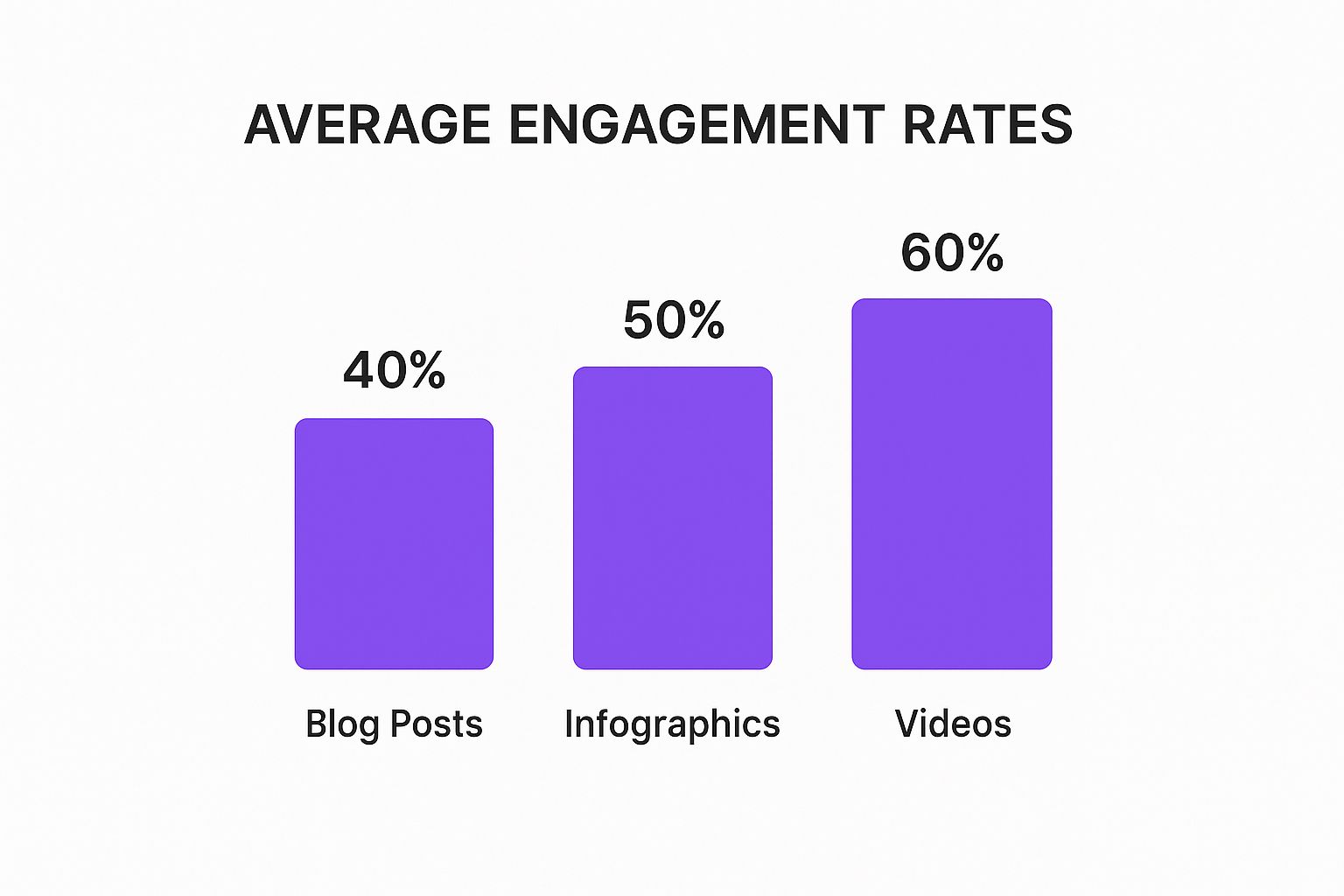Digital Marketing for Startups a Growth Playbook
Let's get one thing straight: for a startup, digital marketing isn't just a "nice to have." It's the whole damn engine. In a world crowded with noise, it’s the ultimate equalizer, giving your fresh idea the firepower to build a brand, pull in leads, and actually compete with the big dogs—all without needing a venture-sized war chest. A smart strategy is your playbook for turning that brilliant concept into a business people can actually find and buy from.
Why Digital Marketing Is Your Startup’s Lifeline

Here's a hard truth: visibility is everything. A startup without a digital marketing plan is like a world-changing invention locked in a garage. The potential is massive, but it's completely invisible to the people who need it most. This guide isn't about theory; it's an actionable playbook full of battle-tested tactics to get you moving from day one.
The biggest hurdle for any startup? Finding customers without going broke. Forget expensive billboards and glossy magazine ads; digital channels offer a direct and, more importantly, measurable path to your first users. Through hyper-targeted campaigns, you can zero in on specific audiences with surgical precision, making every single dollar you spend work its tail off.
The Great Equalizer for New Businesses
Digital marketing completely levels the playing field, letting you punch way above your weight class. Sure, you might not have the nine-figure budget of an industry giant, but you’ve got something they lost long ago: agility, focus, and the ability to connect with a niche audience on a truly human level. That’s your secret weapon.
Get it right, and you can:
- Build Credibility and Trust: You don't need a 50-year history to be seen as an authority. With genuinely valuable content and a little social proof, you can establish your brand as the go-to expert in your corner of the world.
- Generate High-Quality Leads: Stop casting a wide, expensive net. Instead, you can attract potential customers who are already out there, actively searching for exactly what you offer.
- Measure and Optimize for Growth: Every click, every signup, every interaction is a piece of data. This constant feedback loop lets you see what's working, ditch what isn't, and pour fuel on the fire of your most effective tactics.
A startup's most powerful asset is its ability to learn and pivot—fast. Digital marketing delivers the real-time data you need to make smart decisions, turning your marketing budget from a simple expense into a strategic investment in real, sustainable growth.
Think of this guide as your roadmap. We’re about to walk through the essential channels and frameworks that drive actual results.
Building a Resilient Startup Marketing Foundation

Jumping straight into paid ads or pumping out content without a plan is like building a house on sand. Sure, it might look okay for a minute, but it’s absolutely destined to collapse. A strong digital marketing for startups strategy starts with a rock-solid foundation, making sure every dollar you spend and every post you publish is purposeful and tied directly to your business goals.
This foundational work isn't the sexy part, but it's hands-down the most critical piece of the puzzle. It's about getting brutally honest about who you're talking to, what you're trying to achieve, and why anyone should even care. Nail these three pillars, and you'll save yourself a world of wasted time, money, and headaches down the road.
Think of this section as the architectural blueprint for your startup’s growth. Let's define your audience, set your goals, and sharpen your message until it cuts right through the noise.
Defining Your Ideal Customer Persona
You can't sell to everyone. Trying to means you'll end up connecting with no one. The first order of business is to move past vague demographics and build a detailed Ideal Customer Persona (ICP). This is a semi-fictional character who represents your perfect customer, grounded in real data and actual market research.
A truly effective persona goes way deeper than "millennials in urban areas." It captures their professional headaches, their personal ambitions, and the specific pain points your product actually solves. The goal is to get so deep inside their world that you can speak their language and solve their problems before they even have to ask.
Your ideal customer persona isn't just a marketing exercise; it's the North Star for your entire company. It should influence product development, sales conversations, and customer support, not just your ad copy.
To build a persona that actually works, ask yourself these questions:
- What's their job, and what are their biggest on-the-job frustrations? A project manager, for example, might be tearing their hair out over clunky communication tools.
- What are their goals and motivations? Are they gunning for a promotion, desperate to save time, or just trying to reduce their daily stress?
- Where do they get their information? Do they read specific industry blogs, listen to certain podcasts, or follow particular influencers on LinkedIn?
- What are their biggest objections to trying something new? Are they worried about the budget, scared of risk, or just overwhelmed by all the options out there?
Setting SMART Goals for Traction
Once you have a crystal-clear picture of your customer, the next step is to define what success actually looks like. Vague goals like "increase brand awareness" are totally useless for a startup. You need specific, measurable targets that directly fuel business growth. This is where the SMART framework comes in.
Your goals have to be:
- Specific (e.g., "Acquire our first 100 paying customers")
- Measurable (Track sign-ups and conversions—no guesswork)
- Achievable (Is 100 customers realistic this quarter? Be honest.)
- Relevant (Does this goal directly impact revenue and prove our concept?)
- Time-bound (Set a hard deadline, like "by the end of Q3")
This approach turns fuzzy ambitions into an actionable checklist. For an early-stage startup, your main goal might be validating product-market fit. A great SMART goal could be: "Achieve 20% monthly active user growth among our target persona within the next six months."
Crafting an Unforgettable Unique Value Proposition
Finally, you have to answer the single most important question a potential customer has: "Why should I choose you?" Your Unique Value Proposition (UVP) is the short, powerful answer. It’s not a fluffy slogan; it’s a clear statement that explains the benefit you offer, how you solve your customer's problem, and what makes you different from everyone else.
A killer UVP should be:
- Clear and concise: Someone should get it in five seconds.
- Benefit-oriented: It’s all about the outcome for the customer.
- Unique: It highlights what makes you the only real choice.
Take Stripe, for example. Their UVP is "Payments infrastructure for the internet." It's simple, speaks directly to their developer audience, and nails their core function instantly. Your UVP becomes the bedrock of all your messaging, guiding everything from your website headline to your ad copy.
Choosing Your Core Digital-Marketing Channels
Let's get one thing straight: the digital world is a massive, noisy party. If you show up and try to talk to everyone at once, you'll just end up with a sore throat and an empty wallet. Smart digital marketing for startups isn’t about being everywhere—it’s about showing up in the right places with a message that actually lands.
Instead of a dry list of definitions, let's break down the “Big Four” channels that are the real engine for startup growth. Don't think of them as separate items on a checklist. Picture them as gears in a machine. When one starts turning, it helps move the others, building the kind of momentum that actually drives a business forward.
Content Marketing: The Trust-Building Engine
Content marketing isn't about pitching your product. It’s the art of solving your audience's problems before they ever think about buying from you. You’re giving away value—through blog posts, videos, guides, whatever—to earn their trust and attention.
By answering their most burning questions, you stop being just another vendor and start becoming the go-to expert they rely on. For a startup, that trust is gold. It’s an asset that keeps paying you back long after you hit "publish." A solid content marketing for startups guide can be a great roadmap for this, showing you how to create stuff people actually want to read and share.
This quick snapshot shows which content types tend to grab the most attention.

No surprise here—dynamic formats like video are crushing it. People are far more likely to stick around for something that moves and talks than a wall of text.
SEO: Your 24/7 Salesperson
Search Engine Optimization (SEO) is how you make sure people who are actively looking for a solution like yours can find you on Google. Think of it as setting up shop on the busiest street in the digital world. The better your spot (your ranking), the more free, organic foot traffic you get. Simple as that.
SEO and content marketing are best friends. Your awesome blog posts and guides are the products on your shelves. SEO is what makes sure your shop is easy to find, the sign is legible, and the door is wide open for customers. It’s a long game, for sure, but once it gets going, SEO can become your most reliable and cheapest source of high-quality leads.
SEO isn't a "set it and forget it" task. It's an ongoing process of tuning your content to match what your audience is actually typing into that search bar. It's your quietest, hardest-working salesperson, bringing in qualified prospects around the clock.
Paid Ads: The Growth Accelerator
While SEO is a slow-burn marathon, paid advertising—think Google Ads or social media ads—is the sprint. It’s your on-demand button for growth. You can put your message directly in front of a super-specific audience and start seeing traffic and data almost immediately.
This is a game-changer for startups. Need to test if your messaging works? Want to see if people actually want your new feature? Instead of waiting months for organic traffic, you can spin up a targeted ad campaign and get real visitors in a matter of hours. That immediate feedback loop is priceless for refining your strategy with real data, not just gut feelings.
Email Marketing: The Relationship Nurturing Powerhouse
Okay, so you got people to your site with your killer content, SEO, or paid ads. Now what? This is where email marketing comes in. It’s the channel that turns a one-time visitor into a long-term fan and, eventually, a customer.
Email is your direct line to your audience. It’s where you nurture those leads, share exclusive insights, and gently guide them toward making a purchase. It's easily the most personal channel of the bunch. By sending the right messages to the right people at the right time, you build a real community. For a new company, that direct connection is vital for getting feedback, building loyalty, and driving repeat business. If you want to turn that traffic into actual revenue, diving deep into lead generation for startups is your next logical move: https://rebusadvertising.com/blogs/lead-generation-for-startups/
Startup Digital Marketing Channel Comparison
To help you decide where to put your first dollars and hours, here’s a quick-and-dirty comparison of how these four channels stack up for a typical startup.
| Content & SEO | Low to Medium | 6-12 Months | Building long-term authority, trust, and a sustainable flow of organic traffic. |
|---|---|---|---|
| Paid Ads (PPC) | Medium to High | 1-3 Months | Getting immediate traffic, testing offers, and landing those critical first customers fast. |
| Email Marketing | Low | 1-3 Months | Nurturing leads you already have, building loyalty, and driving repeat sales. |
The most successful startups don't just pick one channel and pray. They build a system where each part helps the others. Your content gives your SEO something to rank. Your paid ads drive traffic to that amazing content. And your email marketing keeps the conversation going with all the leads you generate. Focus on these pillars, and you’ll build a marketing engine that can actually power your growth from day one.
Using Social Media and Influencer Partnerships

For a startup, social media isn't just a megaphone for company announcements. Think of it as your digital town square, the place where you can build a real community around your mission. The goal isn't to rack up followers for vanity's sake; it's to build a tribe of genuine fans who believe in what you’re doing and are fired up to be part of the ride.
This means you can't just copy-paste the same update everywhere. You have to treat each platform like its own unique ecosystem with its own rules. LinkedIn, for example, is your digital boardroom—perfect for forging B2B relationships and cementing your authority. On the flip side, Instagram is where your brand's human side comes out to play, using Stories and Reels to show off your company culture or the real-world impact of your product.
Real social media success means listening more than you talk. It's about joining conversations, not just shouting into the void.
Choosing Platforms That Actually Align with Your Audience
Don't fall into the classic trap of trying to be everywhere at once. That’s a one-way ticket to burnout and a lot of mediocre content. Instead, focus your fire where your ideal customers are already hanging out. A killer digital marketing for startups strategy starts with surgical precision, not a shotgun blast.
To narrow your focus, ask yourself these crucial questions:
- Who are you trying to reach? If you're targeting B2B pros, LinkedIn and X (formerly Twitter) are non-negotiable. If your audience is younger and lives on visual content, Instagram and TikTok should be your top priorities.
- What are you selling? A gorgeous physical product, like a piece of hardware or a fashion item, is made for platforms like Instagram and Pinterest. But a complex SaaS tool? That might be better explained through detailed threads on X or deep-dive articles on LinkedIn.
- What are your resources, really? Let’s be honest—video content is a beast, but it demands a lot more time and money to produce. If you're a one-person marketing show, it’s probably smarter to master text-based platforms first before you dive into video.
One of the most powerful shifts happening right now is the explosive growth of social advertising and influencer collaborations. The global market for social media ads is set to jump by 12% this year, proving just how essential these platforms are. Startups, in particular, are flocking to this channel for its sharp targeting and cost-effectiveness.
Even more telling, 59% of marketers are planning to increase their influencer partnerships in 2025. This isn't a fluke; it's a direct response to a consumer shift toward authentic, personality-driven marketing. The numbers back it up: 76% of social media users say content on these platforms has swayed their buying decisions. The effect is even stronger with Gen Z, where a staggering 90% report being influenced by social content, and 41% now use social media as their primary source for information—yep, even more than search engines.
Finding and Collaborating with Micro-Influencers
When you hear "influencer marketing," don't picture paying a Kardashian millions for a single, soulless post. For startups, the real magic is with micro-influencers. These are creators with smaller, super-engaged followings (usually 10,000 to 50,000 followers) who have built incredible trust within a specific niche.
Think of micro-influencers as trusted friends giving a recommendation, not a celebrity reading from a script. Their endorsement feels real and carries serious weight, making them the perfect partner for a startup watching its budget.
The key is structuring these partnerships to create authentic buzz that actually drives conversions.
How to Structure a Winning Partnership:
Identify the Right Fit: Look for influencers whose values and audience demographics are a perfect match for your brand. Forget follower counts; their engagement rate is what truly matters.
Offer Value, Not Just Cash: Many micro-influencers are open to collaborations that go beyond a paycheck. Offer them early access to your product, co-create content with them, or give them a unique affiliate code so they get a cut of the sales they generate.
Grant Creative Freedom: The absolute worst thing you can do is hand an influencer a rigid script. They know their audience better than you do. Give them clear goals and key messages, then step back and trust them to create content in their own unique voice.
Track Everything: Use unique discount codes, custom UTM links, and affiliate tracking to measure the direct impact of every partnership. This data is gold—it’ll show you exactly which collaborations are delivering a real return on your investment.
By focusing on genuine community building and smart influencer partnerships, you can transform social media into a powerhouse for growth. To dig deeper into building a presence from the ground up, check out our guide on social media marketing for a small business.
Budgeting for and Investing in Digital Ads
For a startup, every dollar is under a microscope. Your marketing budget isn’t an expense line—it’s a strategic investment. Paid advertising can feel like a high-stakes poker game, but modern self-service platforms from Google and Meta have completely changed the rules. You now have the power to run hyper-targeted campaigns that were once reserved for mega-corporations with bottomless pockets.
The trick is to focus on performance-driven channels where you can actually see what your money is doing. Instead of throwing cash at a billboard and just hoping for the best, you can pour it into pay-per-click (PPC) ads and watch exactly how many clicks, leads, and sales each dollar generates. This direct feedback loop is everything for making smart, data-backed decisions.
Allocating Your First Ad Budget
The number one mistake startups make? Spreading their budget too thin across too many platforms. It’s like trying to water a giant garden with a single watering can. A much smarter move is to start small and focused. Carve out a modest test budget—even just a few hundred bucks—for one or two channels where your ideal customer actually lives online.
Think of your initial ad spend like a scientific experiment. Your goal isn't immediate, massive profit; it's to gather data. You're testing your messaging, your audience targeting, and your offer to see what resonates before you scale up.
Once you find a channel that’s actually delivering a positive return, you can confidently double down. This methodical approach minimizes your risk and ensures your precious capital is building real momentum, not just racking up empty clicks.
The Power of Self-Service Ad Platforms
The explosion in digital advertising is no accident—it's more accessible than ever. Global digital ad spending rocketed past $790 billion in 2024, now claiming a massive 72.7% of all ad investment worldwide. That’s a huge leap from just under half back in 2018. This surge is fueled by self-service platforms that let anyone, from a solo founder to a small team, run sophisticated campaigns without a giant agency. You can explore a deeper analysis of this rapid growth in digital advertising on DataReportal.com.
This democratization of advertising means you can compete on a much more level playing field. Being clever, targeted, and data-driven now matters more than the size of your bank account.
Common Budgeting Mistakes to Avoid
As you start pouring money into ads, be sure to sidestep these classic startup traps:
- Ignoring Customer Lifetime Value (LTV): Don't just obsess over the profit from that first sale. If a customer is likely to come back and buy again (and again), you can afford to spend a whole lot more to get them in the door.
- Chasing Vanity Metrics: Clicks and impressions feel good on a report, but they don't pay the bills. The only numbers that really matter are your conversions, cost per acquisition (CPA), and return on ad spend (ROAS).
- Setting It and Forgetting It: Ad campaigns are not a crockpot. They need constant attention. Check in on your performance daily and be ready to tweak your targeting, ad copy, and bids to squeeze out better results.
By avoiding these pitfalls and staying laser-focused on measurable outcomes, you can turn your ad budget into a powerful growth engine. For a deeper dive into making every dollar count, our comprehensive guide on paid social media advertising lays out the exact strategies you need to maximize your return: https://rebusadvertising.com/paid-social/
Measuring the Metrics That Actually Matter
Marketing without measurement is just expensive guesswork. For a startup, every single dollar has to pull its weight, which means you’ve got to get good at turning raw data into smart decisions. It’s incredibly easy to get lost in a sea of numbers.
The secret is to tune out the noise—the distracting vanity metrics—and lock in on the key performance indicators (KPIs) that signal a genuinely healthy, growing business.
Vanity metrics, like page views or social media likes, feel great but tell you almost nothing about your company's health. They don't tie directly to revenue or customer growth. Your digital marketing for startups strategy needs to be built around metrics that answer one simple question: "Is this actually working?"
From Vanity to Viability
The first step is a mental shift: stop tracking activity and start tracking impact. A thousand new Instagram followers mean nothing if none of them ever visit your website or sign up for your product. True growth metrics are tied directly to the customer journey and your bottom line.
Here are the essential metrics that truly matter for an early-stage company:
- Conversion Rate: This is the percentage of people who take the action you want them to, like signing up for a newsletter or buying something. A high conversion rate is proof that your messaging and user experience are hitting the mark.
- Customer Acquisition Cost (CAC): This is the total cost of your sales and marketing efforts divided by the number of new customers you brought in. Your goal is to keep this number as low as humanly possible without sacrificing quality.
- Customer Lifetime Value (LTV): This metric forecasts the total revenue a single customer will bring in over their entire relationship with your company. A high LTV is a sign of strong customer loyalty and a product people love.
The golden rule for a sustainable business is dead simple: your LTV must be significantly higher than your CAC. A common benchmark to shoot for is an LTV:CAC ratio of at least 3:1. If it costs you $100 to land a customer who only ever spends $50, you have a serious, business-breaking problem.
Building Your Startup Growth Dashboard
To keep these vital signs front and center, you need a simple weekly or monthly dashboard. This doesn’t have to be some fancy, expensive software; a basic spreadsheet is all you need to get started. Your dashboard should give you an at-a-glance view of your most critical KPIs.
Think of your dashboard as the cockpit of your startup. It gives you the real-time data needed to navigate, adjust your course, and confidently explain your marketing ROI to investors, your team, and yourself.
A solid startup growth dashboard should track:
Lead Generation: How many new leads (like email signups or demo requests) did you get this week?
Lead-to-Customer Rate: What percentage of those leads turned into actual paying customers?
CAC: How much did it cost, on average, to acquire each new customer this month?
LTV: What is the average projected value of your customers? (Even an estimate is better than nothing.)
Churn Rate: What percentage of customers did you lose over a given period?
This intense focus on actionable data gives you the power to justify your budget, make intelligent pivots, and build a marketing engine that fuels real, sustainable growth. In the end, your marketing success boils down to your ability to drive sales; check out these strategies for improving website conversion rates to turn more of those hard-won visitors into customers.
Your Top Startup Digital Marketing Questions, Answered
Alright, let's cut through the noise. When you're building a startup, a million marketing questions pop up. Instead of letting them paralyze you, let’s tackle the big ones head-on with some straight-up, practical advice.
How Much Should My Startup Actually Budget for Digital Marketing?
Look, there's no magic number that fits everyone, but a solid rule of thumb for an early-stage startup is to earmark 10-20% of your projected revenue for marketing. This gives you a scalable starting point that grows as you do.
But what if you're pre-revenue? In that case, forget percentages. Think in terms of a fixed, experimental budget. Set aside a specific dollar amount you're comfortable "risking" to test one or two channels you believe have high potential. The goal isn't to get rich overnight; it's to gather priceless data on what works before you pour more fuel on the fire.
Should I Hire a Full-Timer or Start with Freelancers?
For most startups, jumping straight to a full-time hire is like buying a house for a first date—way too much commitment, way too soon. Kicking things off with specialized freelancers or a fractional CMO is almost always the smarter, more cost-effective play. This approach gives you instant access to top-tier skills in things like SEO or paid ads without the heavy overhead of a salary and benefits.
Think of it as renting an expert's brain only when you need it. The time to hire your first full-time marketer is after you’ve found a profitable, repeatable channel and need someone in-house to own it and scale it. Let your payroll grow because of proven success, not just in hopes of it.
For most startups, starting with specialized freelancers or a fractional CMO is more cost-effective. It gives you access to expert skills... without the commitment of a full-time salary.
My Budget Is Tiny. Which Channel Should I Go All-In On?
When cash is tight, you have to be ruthless with your focus. Pour every ounce of your energy and every dollar of your tiny budget into the one channel where your ideal customers are most active and—this is the critical part—have the highest purchase intent.
For many, that means zeroing in on SEO and Content Marketing. Sure, it’s a long game, but creating genuinely helpful content that solves a real problem for your audience builds an asset that pays dividends forever. Over time, that asset starts generating qualified, organic leads while you sleep, for free.
Need to see results and gather data faster? A small, hyper-targeted paid search campaign can give you that immediate feedback loop, showing you exactly which messages make people click.
Ready to stop guessing and start growing? The expert team at Rebus builds data-driven digital marketing strategies that deliver real results for startups. Let's build your growth engine.
